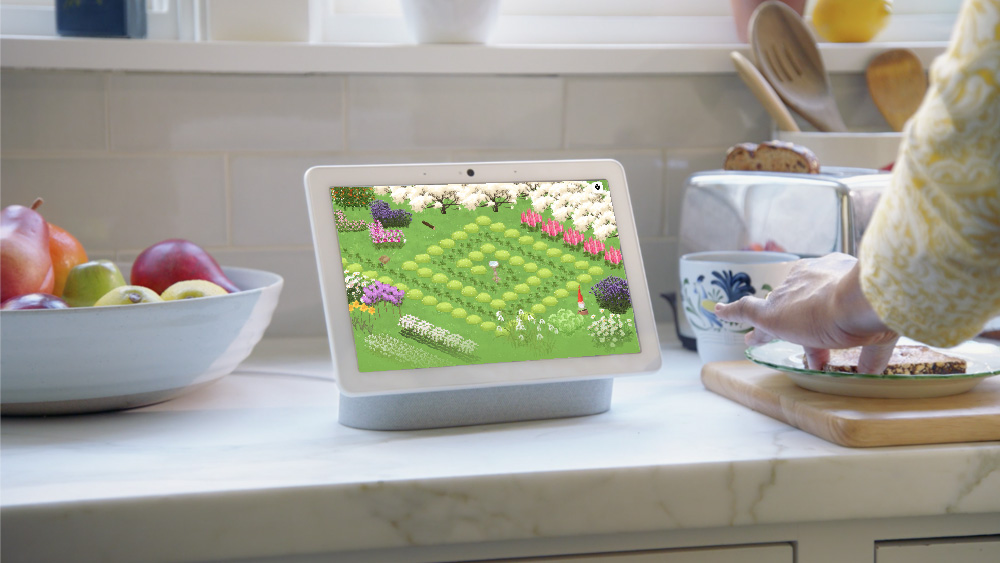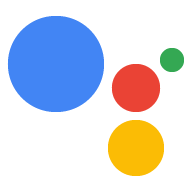가장 빠르게 성장하는 홈 기기 중 하나인 스마트 디스플레이는 게임을 위한 새로운 플랫폼입니다. 디스플레이가 있는 Google 어시스턴트 기기는 풍부한 비주얼과 말하는 게임으로 플레이어를 즐겁게 할 수 있는 좋은 기회를 제공합니다.
스마트 디스플레이용으로 빌드하는 이유와 방법과 게임을 더 많은 기기로 확장하는 방법을 알아보세요.
스마트 디스플레이를 위한 디자인
스마트 디스플레이는 주방 조리대, 소파 옆, 패밀리룸 등 새로운 게임 공간을 제공합니다. 사람이 많고 사람이 많이 거주하는 공간에 있으면 집에 있는 누구나 거의 모든 곳에서 기기를 사용할 수 있습니다. 단어 몇 개만 입력하면 여러 사용자가 게임에 빠르게 액세스할 수 있습니다.

스마트 디스플레이 기기 주변의 놀이 공간은 다른 게임 플랫폼과 다릅니다. 여러 사용자가 같은 방에 있을 수 있으며 게임 이외의 활동이 동시에 발생할 수 있습니다. 이 환경은 게임 빌드를 위한 몇 가지 고유한 과제와 기회를 제공합니다.
- 먼 거리에서의 상호작용: 플레이어가 여기저기 돌아다니면서 몇 단계 떨어진 곳에 있을 때 기기에 대고 말하면, 기기와 상호작용하는 동안 디스플레이를 보지 않을 수 있습니다. 이 점을 염두에 두고 게임은 음성 상호작용을 통해 완전히 플레이할 수 있어야 하고 화면을 터치해야 하는 플레이어에게 의존하지 않아야 합니다. 또한 멀리 떨어져 서 있는 플레이어가 읽을 수 있는 게임 시각 자료를 디자인해야 합니다.
- 다중 플레이어 동시 입력: 스마트 디스플레이는 여러 사람이 참여하는 게임에 적합하므로 한 번에 두 명 이상의 플레이어를 참여시키는 방법을 고려하세요. 이를 염두에 두고 기기의 여러 사용자가 게임의 그래픽을 쉽게 즐길 수 있는지 확인하세요.
- 공유된 공용 공간: 스마트 디스플레이는 거실 및 주방과 같이 유동 인구가 많은 장소에 있는 경우가 많습니다. 게임이 요리, 청소, 숙제, 친근한 토론 등 게임플레이 중에 진행되는 다른 활동과 어떻게 섞이거나 조합될 수 있는지 고려하세요.
효과적인 음성 인터페이스를 만들기 위한 자세한 원칙을 알아보려면 대화 디자인 사이트를 참고하세요. 또한 Android의 TV용 디자인 원칙을 확인해 볼 수 있습니다. 이 원칙에서는 멀리 떨어진 플레이어 상호작용을 디자인하는 데 유용한 유사하고 유용한 권장사항을 공유합니다.
기술 측면에서 Google 어시스턴트 개발자 플랫폼은 친숙한 웹 개발 도구를 사용하여 스마트 디스플레이용 게임을 빌드하기 위한 Interactive Canvas 프레임워크를 제공합니다. 이 프레임워크를 사용하면 전체 화면 시각적 및 대화형 환경을 빌드할 수 있습니다. 개발자 문서에서 Interactive Canvas로 빌드하는 방법을 자세히 알아보세요.
음성으로 비주얼 게임 빌드
초기 게임 콘솔에서 최신 모바일 게임에 이르기까지 플레이어는 게임에서 뛰어난 시각적 경험을 기대하기로 했습니다. 스마트 디스플레이는 플레이어를 위한 환경을 만들고 새로운 차원인 음성에 참여할 수 있는 방법을 제공합니다.
 스마트 디스플레이는 음성 인터페이스의 빠른 속도에 친근한 대형 터치스크린을 제공하여 기존 게임에서 음성 지원 게임 환경으로의 다리 역할을 합니다. 플레이어는 "Hey Google, 게임하자"라고 말하기만 하면 빠르게 게임을 시작할 수 있습니다. 사용자가 익숙하지 않은 영역에 들어가면
화면에 편안한 입력 옵션이 추가로 제공됩니다.
스마트 디스플레이는 음성 인터페이스의 빠른 속도에 친근한 대형 터치스크린을 제공하여 기존 게임에서 음성 지원 게임 환경으로의 다리 역할을 합니다. 플레이어는 "Hey Google, 게임하자"라고 말하기만 하면 빠르게 게임을 시작할 수 있습니다. 사용자가 익숙하지 않은 영역에 들어가면
화면에 편안한 입력 옵션이 추가로 제공됩니다.
Google 어시스턴트 생태계에서 디스플레이 기능과 음성 인터페이스를 모두 갖춘 기기를 타겟팅하면 플레이어의 참여와 즐거움을 주고 지원하는 두 가지 방법을 통해 게임의 성공 가능성을 높일 수 있습니다.
더 많은 기기로 도달범위 확대
Google 어시스턴트는 스마트 디스플레이 외에도 다양한 방법으로 작동합니다. 먼저 스마트 디스플레이에 맞게 설계해야 하지만 게임을 플레이할 수 있는 다른 Google 어시스턴트 기기를 기록해 둡니다. 특히 스마트폰은 기기 인구의 큰 부분을 차지하며 스마트 스피커의 사용이 계속 증가하고 있습니다.
스마트폰에 맞게 조정
스마트폰에 맞게 Google 어시스턴트 게임을 최적화하려면 다음 단계를 따르세요.
- 반응형 디자인 사용: 반응형 웹 디자인 기법을 사용하여 다양한 화면 크기, 특히 작은 휴대전화 화면에 맞게 조정합니다. Google 어시스턴트는 시각 효과를 위해 HTML 기술을 사용하므로 게임의 반응형 디자인에 관해 이미 알고 있는 기능을 대부분 사용할 수 있습니다.
- 볼륨 고려: 스마트폰은 이동 중에 사용되므로 플레이어는 종종 볼륨을 낮추거나 끕니다. 플레이어에게 게임을 시작할 때 볼륨을 확인하도록 상기시키는 것은 좋은 생각이지만, 플레이어는 조용한 모임이나 시끄러운 출퇴근길과 같이 장소 때문에 소리를 사용하지 못할 수도 있습니다. 음성 외에도 터치를 통해 게임을 탐색할 수 있도록 하여 설계에 이를 반영하고 오디오 메시지에 포함된 중요한 정보도 화면에서 읽을 수 있도록 해야 합니다.
스마트 스피커에 맞게 조정
플레이어가 게임에 더 익숙해질수록 숙련된 플레이어에게 음성 전용 인터페이스가 적합할 수 있으며 신규 플레이어가 게임을 더 쉽게 이용하게 할 수 있습니다.
게임 플레이를 제한 모드로 축소하거나 정보 제공 모드로 전환하여 오디오 전용 모드에서 게임이 어떻게 작동하는지 고려하세요. 예를 들어 플레이어가 음성 전용 기기에서 게임을 활성화하면 게임 기능, 뉴스, 미션 업데이트 또는 리더보드 상태에 관한 업데이트를 제공할 수 있습니다.
스피커의 음성 전용 상호작용 디자인에 관한 자세한 내용은 대화 설계 사이트를 참고하세요.

